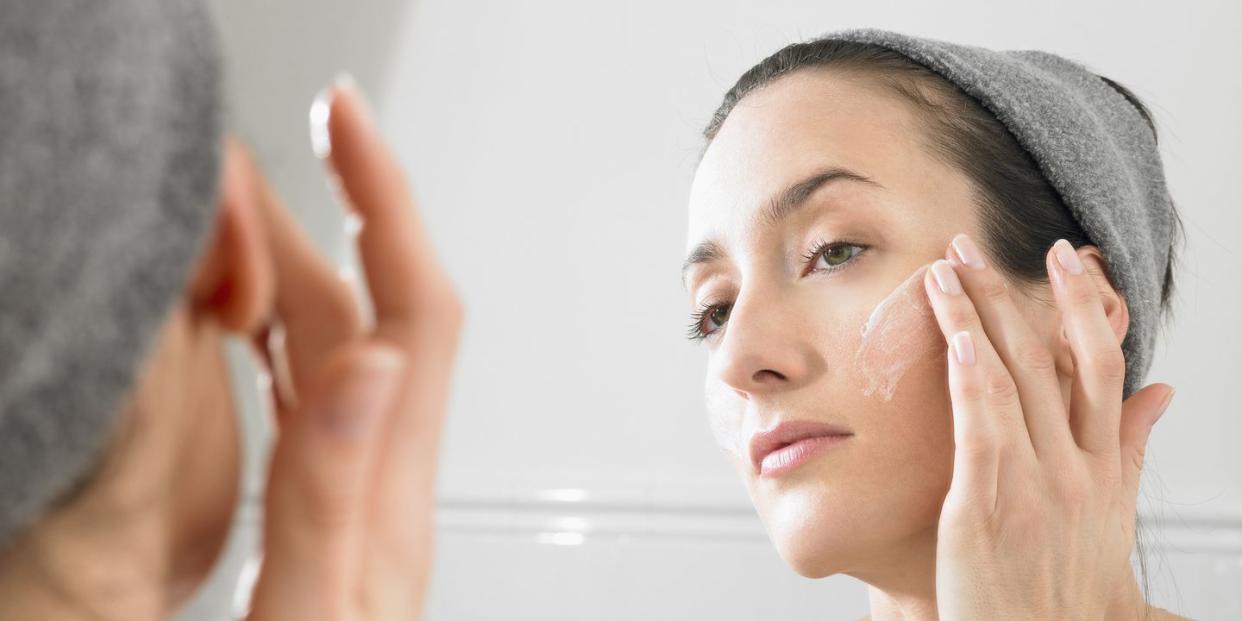3 Dermatologist-Approved Ways to Treat (and Prevent) Rosacea Flare-Ups

According to the National Rosacea Society, 16 million-plus Americans regularly deal with symptoms of rosacea. Flare-ups can feel like a nightmare: the patchy pink spots, the all-over facial redness, red pus-filled pimples, and visible blood vessels. If you experience them, just know you’re not alone.
Although the ups and downs of the skin condition can be difficult to manage at times, dermatologists say there are plenty of rosacea treatment options (at-home and medical) that can actually reduce embarrassing flushing and breakouts. Keep reading for rosacea treatment tips, prevention, and symptoms to know, outlined by the pros.
Rosacea symptoms
Rosacea typically appears on the face’s central areas like cheeks, nose, and forehead, explains Heidi A. Waldorf, M.D., a board-certified dermatologist and founder of Waldorf Dermatology Aesthetics in New York. Facial flushing is the most common symptom, which occurs when the blood vessels close to the skin get inflamed and dilated. Other symptoms include pimples and bumps—that should not be mistaken for acne—visible blood vessels and watery or bloodshot eyes.
During a rosacea flare-up, which is when the condition is visible on the face, you may also experience burning, stinging, and facial warmness and dryness. This can be very uncomfortable and disturbing, but you can do something about it.
How to treat Rosacea
Derms find these treatments to be the most effective for preventing and treating rosacea:
Apply a cold compress
For oncoming flare-ups, a cold compression could be all it takes to keep your rosacea from manifesting. “If you feel a flush coming on, apply ice (or a cold bottle of water or glass with ice) to your face and neck,” Dr. Waldorf says. This will calm the skin and reduce facial inflammation.
Try topical or oral antibiotics
Depending on the rosacea type or the severity of a flare-up, it may require prescription medication, says Nianda Reid, M.D., a board-certified dermatologist at Dermatology & Mohs Surgery Center in Pennsylvania. You can gauge the severity based on symptoms. So if your eyes are bloodshot and swollen or your facial redness is paired with unbearable burning, you can assume that it’s bad. Topical medication that can be applied directly to affected areas and oral antibiotics taken by mouth can help get your symptoms under control.
The most prescribed antibiotics are brimonidine, oxymetazoline, metronidazole, and ivermectin. “They work to reduce redness and inflammation in the face by constricting blood vessels,” Dr. Reid explains. Dermatologists find that patients who take antibiotics consistently—during and in-between flare-ups—are more likely to have fewer flare-up recurrences on a long-term basis.
Consider procedural therapies
If you’re still red in the face after trying topical and oral medications, laser therapy and other light-based treatments may help. These treatments work by using heat from the laser to penetrate blood vessels, causing them to reduce in appearance. According to the American Academy of Dermatology Association, some patients claim they’ve even seen a complete clearing of redness lasting for years. However, Dr. Reid notes that “repeated and continued treatments (whether topical, oral or laser) may be needed to maintain the clearance of rosacea on your skin.”
Rosacea prevention
There is no cure for rosacea. However, along with treatments, there are ways to reduce the recurrence of it. This is highly dependant on whether you’ve identified your flare-up triggers. “Possible rosacea triggers include sunlight, heat or extreme temperature, wind, exercise, caffeine, spicy food, stress, alcohol, medications such as steroids, or other irritating topical products,” Dr. Reid says. If you find that specific ones are causing your rosacea to manifest, then avoid them. But if you can’t, consider some of the above treatment options ahead of time to plan for a potential flare-up.
One thing Dr. Reid recommends for all rosacea patients, despite their triggers, is sunscreen. “Sun exposure is known to worsen rosacea, so it is helpful to use a broad-spectrum sunscreen with SPF or sun protective factor 30 and above daily, and especially before sun exposure,” she explains.
Here are a few sunscreen options that are great for daily use. (Pro tip: a tinted SPF will not only protect from UV rays, but knock back your redness a bit, too.)
You Might Also Like

